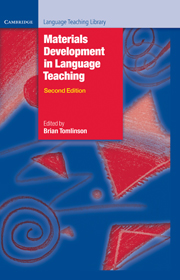Book contents
- Frontmatter
- Contents
- Preface
- Glossary of basic terms for materials development in language teaching
- Acknowledgements
- 1 Introduction: principles and procedures of materials development
- Part A Data collection and materials development
- 2 Using corpora in the language classroom
- 3 Concordances in the classroom without a computer: assembling and exploiting concordances of common words
- 4 Telling tails: grammar, the spoken language and materials development
- Comments on Part A
- Part B The process of materials writing
- 5 A framework for materials writing
- 6 Writing course materials for the world: a great compromise
- 7 How writers write: testimony from authors
- Comments on Part B
- Part C The process of materials evaluation
- 8 The analysis of language teaching materials: inside the Trojan Horse
- 9 Macro- and micro-evaluations of task-based teaching
- 10 What do teachers really want from coursebooks?
- 11 The process of evaluation: a publisher’s view
- Comments on Part C
- Part D The electronic delivery of materials
- 12 Developing language-learning materials with technology
- 13 New technologies to support language learning
- Comments on Part D
- Part E Ideas for materials development
- 14 Seeing what they mean: helping L2 readers to visualise
- 15 Squaring the circle – reconciling materials as constraint with materials as empowerment
- 16 Lozanov and the teaching text
- 17 Access-self materials
- Comments on Part E
- Conclusions
- Recommended reading
- Index
15 - Squaring the circle – reconciling materials as constraint with materials as empowerment
Published online by Cambridge University Press: 09 February 2023
- Frontmatter
- Contents
- Preface
- Glossary of basic terms for materials development in language teaching
- Acknowledgements
- 1 Introduction: principles and procedures of materials development
- Part A Data collection and materials development
- 2 Using corpora in the language classroom
- 3 Concordances in the classroom without a computer: assembling and exploiting concordances of common words
- 4 Telling tails: grammar, the spoken language and materials development
- Comments on Part A
- Part B The process of materials writing
- 5 A framework for materials writing
- 6 Writing course materials for the world: a great compromise
- 7 How writers write: testimony from authors
- Comments on Part B
- Part C The process of materials evaluation
- 8 The analysis of language teaching materials: inside the Trojan Horse
- 9 Macro- and micro-evaluations of task-based teaching
- 10 What do teachers really want from coursebooks?
- 11 The process of evaluation: a publisher’s view
- Comments on Part C
- Part D The electronic delivery of materials
- 12 Developing language-learning materials with technology
- 13 New technologies to support language learning
- Comments on Part D
- Part E Ideas for materials development
- 14 Seeing what they mean: helping L2 readers to visualise
- 15 Squaring the circle – reconciling materials as constraint with materials as empowerment
- 16 Lozanov and the teaching text
- 17 Access-self materials
- Comments on Part E
- Conclusions
- Recommended reading
- Index
Summary
Introduction
A major dilemma faced by all writers of materials, even those writing for small groups of learners with well-defined needs, is that all learners, all teachers and all teaching situations are uniquely different, yet published materials have to treat them as if they were, in some senses at least, the same. A further problem for materials writers is that, although they are well aware that the course, the direction and the pace of learning are largely unpredictable, they have to predetermine all these things.
Prabhu ( 2001 ), among others, has pointed out the constraining effects of materials on the freedom of action of teachers (see Andrew Littlejohn and Hitomi Masuhara’s chapters in this volume). In the interests of efficiency and quality (in one of its definitions at least), the writing of materials is generally delegated to a group of specialists, who produce centrally the materials to be used locally by another group: the teachers in their individual classrooms. (In a very few projects, local teachers at least contribute to the writing team, but this is very much the exception.) In this way, the materials can pre-empt all the important decisions which teachers themselves might otherwise be expected to make. The content is predetermined. The order of the content is predetermined. The rate of progression through the materials is predetermined. The procedures for using the content are also predetermined.
Clearly, what actually happens in classrooms using published materials is that there is a complex trade-off between the three major elements in the equation: the materials, the teacher and the learners.
In some cases there may be a relatively close fit between the three. This may occur when the materials have been designed for a relatively specific learning group. Even then, owing to individual differences amongst the learners and to teacher factors, there will never be a perfect fit. Such teacher factors include the teacher’s:
• degree of language proficiency and confidence
• previous personal learning experiences as learners rather than as Teachers
• own personality (introvert/extrovert, open/closed, etc.)
• preferred teaching style (directive/consultative, etc.)
• cultural background.
- Type
- Chapter
- Information
- Materials Development in Language Teaching , pp. 379 - 402Publisher: Cambridge University PressPrint publication year: 2011
- 20
- Cited by

